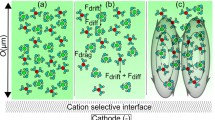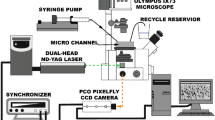Abstract
ACEO-induced vortices have been used to manipulate fluids and particles for chemical and biochemical analysis in microscale systems. In such applications, a pressure-driven background flow is often applied to deliver the samples or particles into the target region. In the present study, the influence of an axial background flow on ACEO-induced vortices is experimentally investigated. An array of symmetric electrodes is used, perpendicular to the axial flow. Velocity fields of vortical flow are measured using astigmatism \(\mu\)-PTV. The strength of vortex is quantified as a function of the axial background velocity. Flow measurements with 2-\(\upmu \hbox {m}\) tracer particles reveal that the background flow compresses the ACEO-induced vortices and decreases the vortex size. This vortex region, separated from the background flow, can be seen as an “isolated area” in the microchannel. Next, 5-\(\upmu \hbox {m}\) particle dynamics in such flow with isolated vortical area is investigated. Experimental observations expose that 5-\(\upmu \hbox {m}\) particles do not follow the vortical flow and are focused toward the upper side of the channel. The velocity components of the 5-\(\upmu \hbox {m}\) particles are found to be different with the local flow visualized by the 2-\(\upmu \hbox {m}\) particles. This velocity difference of 5-\(\upmu \hbox {m}\) particles is probably due to the dielectrophoretic force acting on the particles. Furthermore, such particle focusing appears to be strongly related to the background velocity.



















Similar content being viewed by others
References
Ajdari A (2000) Pumping liquids using asymmetric electrode arrays. Phys Rev E 61:45–48
Carlo DD (2009) Inertial microfluidics. Lab Chip 9:3038–3046
Castellanos A, Ramos A, Gonzalez A, Green NG, Morgan H (2003) Electrohydrodynamics and dielectrophoresis in microsystems: scaling laws. J Phys D Appl Phys 36:2584–2597
Cierpka C, Segura R, Hain R, Kähler CJ (2010) A simple single camera 3C3D velocity measurement technique without errors due to depth of correlation and spatial averaging for micro fluidics. Meas Sci Technol 21:045401
Cierpka C, Rossi M, Segura R, Kähler CJ (2011) On the calibration of astigmatism particle tracking velocimetry for microflows. Meas Sci Technol 22:015401
Cierpka C, Kähler CJ (2012) Particle imaging techniques for volumetric three-component (3D3C) velocity measurements in microfluidics. J Vis 15:1–31
Felten M, Staroske W, Jaeger MS, Schwille P, Duschl C (2008) Accumulation and filtering of nanoparticles in microchannels using electrohydrodynamically induced vortical flows. Electrophoresis 29(14):2987–2996
Green NG, Morgan H (1999) Dielectrophoresis of submicrometer latex spheres. 1. Experimental results. J Phys Chem B 103(1):41–50
Hilber W, Weiss B, Saeed A, Holly R, Jakoby B (2009) Density-dependent particle separation in microchannels using 3D AC-driven electro-osmotic pumps. Sens Actuators A 156:115–120
Huang SH, Wang SK, Khoo HS, Tseng FG (2007) AC electroosmotic generated in-plane microvortices for stationary or continuous fluid mixing. Sens Actuators B 125:326–336
Jeong J, Hussain F (1995) On the identification of a vortex. J Fluid Mech 285:69–94
Laser DJ, Santiago JG (2004) A review of micropumps. J Micromech Microeng 14:35–64
Liu Z, Speetjens MFM, Frijns AJH, van Steenhoven AA (2014a) Application of astigmatism \(\mu\)-PTV to analyze the vortex structure of AC electroosmotic flows. Microfluid Nanofluid 16(3):553–569. doi: 10.1007/s10404-013-1253-2
Liu Z, Speetjens MFM, Frijns AJH, van Steenhoven AA (2014b) Validated numerical analysis of vortical structures in 3D AC electro-osmotic flows. Microfluid Nanofluid 16(6):1019–1032. doi:10.1007/s10404-014-1377-z
Park J, Song S, Jung H (2009) Continuous focusing of microparticles using inertial lift force and vorticity via multi-orifice microfluidic channels. Lab Chip 9:939–949
Ramos A, Morgan H, Green NG, Castellanos A (1998) AC electrokinetics: a review of forces in microelectrode structures. J Phys D Apply Phys 31:2338–2353
Saffman PG (1965) The lift on a small sphere in a slow shear flow. J Fluid Mech 22:385
Speetjens MFM, Wispelaere HNL, van Steenhoven AA (2011) Multi-functional Lagrangian flow structures in three-dimensional AC electro-osmotic micro-flows. Fluid Dyn Res 43:035503
Stone HA, Stroock AD, Ajdari A (2004) Engineering flows in small devices: microfluidics toward a lab-on-a-chip. Annu Rev Fluid Mech 36:381–411
Vollmers H (2001) Detection of vortices and quantitative evaluation of their main parameters from experimental velocity data. Meas Sci Technol 12:1199–1207
Werely ST, Meinhart CD (2005) Micron-resolution particle image velocimetry. Microscale Diagn Tech 51:112
Wu Z, Liu AQ, Hjort K (2007) Microfluidic continuous particle/cell separation via electroosmotic-flow-tuned hydrodynamic spreading. J Micromech Microeng 17:10
Xuan X, Zhu J, Church C (2010) Particle focusing in microfluidic devices. Microfluid Nanofluid 9:1–16
Zhang C, Khoshmanesh K, Mitchell A, Kalanter-Zadeh K (2009) Dielectrophoresis for manipulation of micro/nano particles in microfluidic systems. Anal Bioanal Chem 396(1):401–420
Author information
Authors and Affiliations
Corresponding author
Rights and permissions
About this article
Cite this article
Liu, Z., Frijns, A.J.H., Speetjens, M.F.M. et al. Particle focusing by AC electroosmosis with additional axial flow. Microfluid Nanofluid 18, 1115–1129 (2015). https://doi.org/10.1007/s10404-014-1504-x
Received:
Accepted:
Published:
Issue Date:
DOI: https://doi.org/10.1007/s10404-014-1504-x




